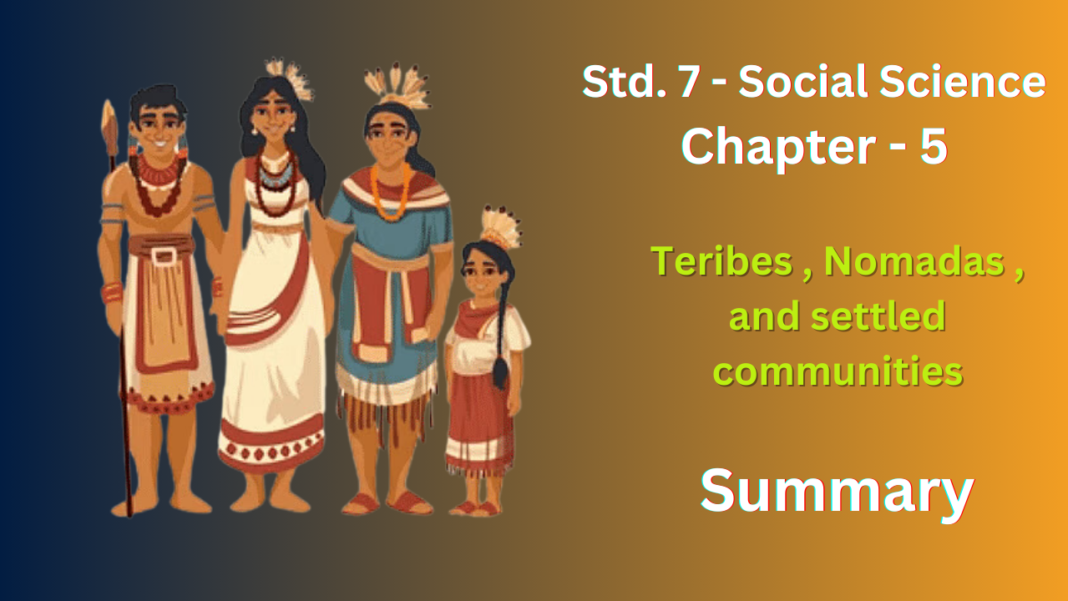NCERT Solutions for Class 7 History Chapter 5
The chapter Teribes Nomadas and settled communities delves into the lives of diverse communities that existed across history, highlighting their unique characteristics and ways of life:
1. The Tribal World:
- Who are Tribes?: You’ll learn about tribes, close-knit communities often bound by kinship, shared traditions, and a common language. They typically have their own social norms, customs, and leadership structures.
- A Life Less Ordinary: Explore the diverse lifestyles of tribes. Some practiced settled agriculture, while others were nomadic, moving from place to place in search of resources. The chapter might introduce you to specific Indian tribes like the Gonds, Bhils, and Mundas, highlighting their occupations, food habits, and cultural practices.
2. Nomadic Communities:
- Always on the Move: Get to know about nomadic communities who constantly move from one place to another. Reasons for their mobility could include seeking better grazing grounds for their animals, following seasonal changes, or pursuing trade opportunities.
- Masters of Adaptation: Nomads develop unique skills and knowledge to survive in challenging environments. The chapter might explore how they adapted their dwellings (like tents), clothing, and social structures to suit their mobile lifestyle.
- Examples of Nomadic Groups: You might encounter examples like the Banjara community in India, known for their expertise in trade and transportation.
3. Settled Communities:
- Rooted in Place: This section focuses on settled communities that have established permanent settlements and practice agriculture as their primary source of livelihood. They build houses, cultivate crops, and often develop complex social structures and administrative systems.
- The Rise of Cities: You’ll learn how settled communities contributed to the rise of villages, towns, and eventually, cities. These urban centers served as centers of trade, administration, and cultural exchange.
4. Interactions and Exchange:
- Not So Different After All: The chapter might emphasize that despite their differences, these communities interacted and influenced each other. Trade routes facilitated exchange of goods, ideas, and cultural practices. Settled communities might have traded with nomads for livestock products, while nomads might have acquired agricultural produce from settled communities.
5. A Legacy that Endures:
- Understanding Our Past: Studying these communities helps us appreciate the diversity of human societies and understand how they adapted to different environments.
- Continuities and Changes: You might learn how some tribal and nomadic communities have retained their traditional ways of life, while others have adapted to changing times.
Exercises
Let’s Recall
Match the following
| Column I | Column II |
| Garh | Khel |
| Tanda | Chaurasi |
| Labourer | Caravan |
| Clan | Garha Katanga |
| Sin Singh | Ahom State |
| Durgawati | Paik |
Ans :
| Column I | Column II |
| Garh | Chaurasi |
| Tanda | Caravan |
| Labourer | Paik |
| Clan | Khel |
| Sin Singh | Ahom State |
| Durgawati | Garha Katanga |
2. Fill in the blanks:
- The new castes emerging within vamas were called……………………
- ……… were historical works written by the Ahoms.
- The…….. mentions that Garha Katanga had 70,000 villages.
- As tribal stales became bigger and stronger they gave land grants to………….. ..
Ans :
- Jatis
- Buraryis
- Akbar Nama
- Temples, Brahmanas.
3. State whether true or false:
(a) Tribal societies had rich oral traditions.
(b) There were no tribal communities in the north-western part of the subcontinent.
(c) The Chaurasi in Gond states contained several cities.
(d) The Bhils lived in the north-eastern part of the sub-continent.
Ans :
(a) True
(b) False
(c) False
(d) False
4. What kinds of exchanges took place between nomadic pastoralists and settled agriculturists?
Ans : Nomadic pastoralists traded livestock products, transport services, and crafts for grains, manufactured goods, and salt from settled agriculturists. This created a network of exchange and interdependence.
Let’s Understand
5. How was the administration of the Ahom state-organized?
Ans :
- Centralized Power: The Ahom state became increasingly centralized, particularly during the 17th century. The king, called the Swargadeo, held ultimate authority.
- Clan System: Ahom society was initially divided into clans (khels), which often controlled several villages. Over time, the power of these clans diminished as the central administration strengthened.
- Paik System: The Ahom state relied on a forced labor system called the Paik system. Adult males were obligated to serve in the military or contribute to public works projects for a certain period.
- Land Management: Peasants were assigned land by their village communities, and even the king couldn’t take it away without their consent. This provided some security for peasants.
- Administrative Divisions: The Ahom state might have used terms like “Chaurasi” to designate administrative divisions, but details about their structure vary.
6. What changes took place in vama-based society?
Ans :
- Emergence of Jatis: Within the existing varnas (Brahmins, Kshatriyas, Vaishyas, Shudras), smaller social divisions called Jatis emerged. These Jatis further stratified society based on occupation, heredity, and regional customs.
- Rise of New Castes: Jatis became more rigid over time, transforming into castes with specific rules governing social interaction, marriage, and professions.
- Position of Brahmins: While Brahmins remained at the top of the social hierarchy, new castes emerged within them, indicating a shift in internal dynamics.
- Incorporation of New Groups: Tribal communities and social groups were brought into the fold of the caste system, often assigned positions based on their perceived social standing.
- Specialized Artisans: Specialized artisans like blacksmiths, carpenters, and masons were recognized as distinct Jatis, highlighting the growing importance of professions.
- Decline of Varnas: Over time, the emphasis on varnas diminished, and Jatis became the primary basis for social organization.
7. How did tribal societies change after being organised into a state?
Ans :
- Social Hierarchy: Tribal societies, often egalitarian, developed more stratified social structures. Leading families might have become nobility, while the majority might have been integrated into the caste system, sometimes at lower levels.
- Loss of Autonomy: Independent decision-making within tribes diminished as they became subjects of a larger state with its own laws and rulers.
- Cultural Blending: Interaction with different cultures within the state could lead to a blending of traditions, religious practices, and languages.
- Land Ownership: Land ownership patterns might have changed. Some tribal communities might have lost control over their traditional lands or faced new systems of taxation.
- Military Integration: Tribes known for warfare might be incorporated into the state’s military, providing a source of soldiers.
- Sanskritization: In some cases, tribal societies might have adopted elements of Hinduism, like rituals or practices, in a process called Sanskritization, seeking to gain higher social status within the state structure.
Let’s Discuss
8. Were the Banjaras important for the economy?
Ans : Absolutely, the Banjaras were very important for the economy during medieval India. Here’s why:
- Mobile Traders: They functioned as nomadic traders, traveling across vast distances with their caravans (called Tandas) to buy and sell goods.
- Essential Goods: They played a crucial role in transporting essential goods like grain, salt, and textiles. They bought these goods from areas where they were cheaper and transported them to places where they were in higher demand. This helped regulate prices and ensure wider availability of necessary items.
- Integration of Markets: The Banjaras connected different regional markets, facilitating trade and promoting economic exchange across the subcontinent.
- Supporting Mughal Empire: The Mughals often relied on the Banjaras for transporting grains to their armies and cities.
9. In what ways was the history of the Gonds different from that of the Ahoms? Were there any similarities?
Ans :
Differences:
- Lifestyle: The Gonds were primarily indigenous inhabitants practicing shifting cultivation in forested regions (Gondwana). In contrast, the Ahoms migrated from Southeast Asia and developed a strong agrarian society in the Brahmaputra Valley.
- Social Structure: Gond society remained relatively less centralized, with power often distributed among independent chiefs. The Ahoms, on the other hand, established a well-organized monarchy with a centralized administration.
- State Formation: While the Gonds formed loose confederacies, they never established a unified state comparable to the Ahom kingdom.
- Military: The Gonds relied on traditional weaponry and guerrilla tactics, while the Ahoms adopted innovative warfare strategies like gunpowder and cannons, making them a formidable force.
Similarities:
- Tribal Roots: Both originated from tribal communities with strong kinship bonds and shared cultural practices.
- Adaptation: Both adapted to their environments – the Gonds to the forests and the Ahoms to the riverine plains.
- Resistance to Empires: Both the Gonds and the Ahoms fiercely resisted the expansion of empires like the Mughals, showcasing their spirit of independence.
- Cultural Influence: Both left a lasting cultural imprint on their respective regions, evident in their art, language, and traditions.
Let’s Do
10. Plot the location of the tribes mentioned in this chapter on a map. For any two, discuss whether their mode of livelihood was suited to the geography and the environment of the area where they lived.
Ans :
11. Find out about present-day government policies towards tribal populations and organise a discussion about these.
Ans : Tribal Policies in India
Government Initiatives:
- Special rights in the Constitution (Scheduled Tribes)
- Tribal Sub-Plan for dedicated funding
- Forest Rights Act for land & resource control
- Eklavya Schools for better education
- Financial inclusion schemes
12. Find out more about present-day nomadic pastoral groups in the sub-continent.
Ans : Nomadic herders like Gujjars (Kashmir) & Gaddis (Himalayas) still exist. They migrate with animals (sheep, goats, camels) for seasonal pastures, living in temporary shelters. Modernization threatens their way of life through habitat loss, climate change, and stricter policies. These communities play a vital role in maintaining ecosystems, holding indigenous knowledge, and enriching cultural heritage.
FAQ’s
What topics are covered in Class 7 History Chapter 5, focusing on tribes nomadas and settled communities ?
Class 7 History Chapter 5 explores the lifestyles, cultures, and interactions of tribes, nomads, and settled communities during ancient times, offering insights into their diverse social structures and economic activities.
How can NCERT Solutions for Class 7 History Chapter 5 enhance understanding of tribes, nomads, and settled communities?
NCERT Solutions for Class 7 History Chapter 5 provide detailed explanations and examples to deepen comprehension of the dynamics between tribes, nomads, and settled communities, fostering a better understanding of ancient civilizations.
Are there specific examples discussed in Class 7 History Chapter 5 to illustrate the characteristics of tribes nomadas and settled communities
Yes, Class 7 History Chapter 5 presents various case studies and historical accounts to illustrate the distinct characteristics and lifestyles of tribes, nomads, and settled communities, facilitating a comprehensive understanding of their societal structures.
Can Class 7 History Chapter 5 shed light on the interactions and exchanges between tribes nomadas and settled communities ?
Absolutely! Class 7 History Chapter 5 delves into the interactions, conflicts, and exchanges that occurred between different groups, highlighting the cultural diffusion and economic transactions that shaped ancient societies.
How do tribes nomadas and settled communities contribute to the historical narrative discussed in Class 7 History Chapter 5?
Class 7 History Chapter 5 recognizes the integral roles played by tribes, nomads, and settled communities in the development of ancient civilizations, emphasizing their influence on social, political, and economic dynamics.









